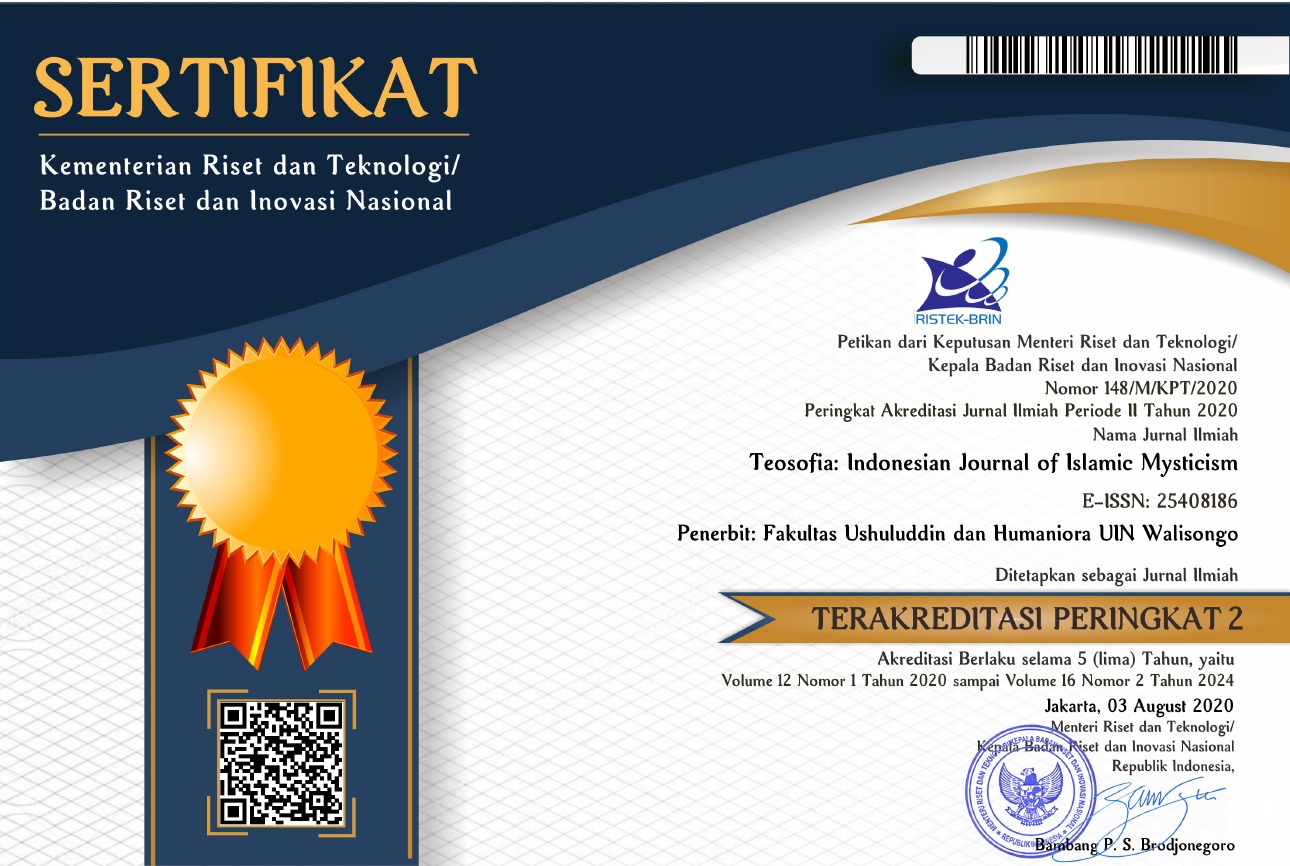Journey to Union: Exploring Ibn Arabi’s Nomadic Philosophy and Imaginal Spaces in Sufism
DOI:
https://doi.org/10.21580/tos.v12i2.17682Keywords:
Nomad thought, journey, hermeneutic approach, Sufism, Ibn Arabi, empty spaceAbstract
This paper sheds light on Ibn Arabi’s philosophy of journey, which takes place in an empty space where mystical characters, noble saints, Prophets and Messengers of God are given a chance to communicate and interact peacefully. Considering the hermeneutics’ approach to Sufi discourse and Gilles Deleuze’s concept of nomad thought, we aim to showcase that Ibn Arabi regards the Sufi wayfarers as “nomadic subjects” as long as they can journey to the inward and outward realms. The intersection of these two antagonistic realms— the realm of Seen (al-hiss) and Unseen (al-ghayb)— liberates the Sufi practitioners from spatio-temporal stagnation and transfers them to endless states and multiple becomings that later evolve into spiritual stations (maqāmāt) of stability and certainty.
Contribution: This article highlights the breadth of Ibn Arabi’s nomadic style of thought in shaping the spiritual journey, arguing that the need to unite with God is expressed through a new style of spiritual movement that occurs in an imaginal space where the Sufi is enabled to communicate via his/her heart with other absentees, including noble saints, Messengers of God and Prophets
Downloads
References
’Arabi, Muhyiddin Ibn. The Secrets of Voyaging. Translated by Angela Jaffray. Oxford: Anqa Publishing, 2015.
Acim, Rachid. “The Foreign and Imaginal In Ibn ‘Arabī’s Turjuman Al-Ashwaq.” Üsküdar Üniversitesi Tasavvuf Araştırmaları Enstitüsü Dergisi 2023, no. 3 (May 2023): 11–25. https://doi.org/10.32739/ustad.2023.3.36.
Al-Hilali, Muhammad Taqi-ui-Din, and Muhammad Muhsin Khan, trans. The Noble Quran. Saudi Arabia: King Fahd Complex for the Printing of the Holy Qur’an, 2018.
Al-ʻArabī, Ibn. Journey to the Lord of Power: A Sufi Manual on Retreat. Translated by Rabia Terri Harris. Vermont: Inner Traditions, 1981.
———. Tarjuman Al-Ashwaq. Translated by Reynold A. Nicholson. London: Royal Asiatic Society, 1911.
———. The Bezels of Wisdom. Translated by R.W.J. Austin. Michigan: Paulist Press, 1980.
Al-Qushayri, Abu al-Qasim. Al-Qushayri’s Epistle on Sufism. Translated by Alexander Knysh. United Kingdom: Garnet Publishing Limited, 2007.
Barghouti, Dia. “Ibn ‘Arabi and the Shadhiliya of Tunisia.” Performance Research 26, no. 4 (May 19, 2021): 11–17. https://doi.org/10.1080/13528165.2021.2005942.
Bouchoir, Tayeb. “The Strategies of Sufi Discourse in Fostering Communal Immunity: The Sufi as a Nomadic Subject.” Insaniyat : Journal of Islam and Humanities 7, no. 2 (May 31, 2023): 157–67. https://doi.org/10.15408/insaniyat.v7i2.29111.
Braidotti, Rosi. Nomadic Theory: The Portable Rosi Braidotti. New York: Columbia University Press, 2012.
Corbin, Henry. Creative Imagination in the Sufism of Ibn Arabi. New Jersey: Princeton University Press, 1969.
Deleuze, Gilles, and Félix Guattari. A Thousand Plateaus Capitalism and Schizophrenia. Minneapolis: University of Minnesota Press, 1987.
———. Nomad Thought. Translated by David Allison. Cambridge: The MIT Press, 1999.
Deleuze, Gilles, and Claire Parnet. “Gilles Deleuze: The ABC Primer / Recording 1 - A to F.” The Deleuze Seminars, 1988. https://deleuze.cla.purdue.edu/seminars/gilles-deleuze-abc-primer/lecture-recording-1-f.
Giddens, Antonio. The Consequences of Modernity. California: Polity Press, 1990.
Griffel, Frank. Al-Ghazali’s Philosophical Theology. Oxford: Oxford University Press, 2009.
Hughes, Thomas Patick. A Dictionary of Islam. London: Oxford University Press, 1885.
Khaldun, Ibn. The Muqaddimah: An Introduction to History. Translated by Franz Rosenthal. United Kingdom: Princeton University Press, 2005.
Liotta, Elena. On Soul and Earth: The Psychic Value Of Place. Translated by Erika Pauli. London: Routledge, 2013.
Marcuse, Herbert. Eros and Civilization : A Philosophical Inquiry into Freud. Boston: Beacon Press, 1955.
Marks, Laura U. Enfoldment and Infinity: An Islamic Genealogy of New Media Art. Cambridge: MIT Press, 2010.
Morris, James Winston. “The Spiritual Ascension: Ibn ʿArabī and the Miʿrāj Part Ii.” Journal of the American Oriental Society 108, no. 1 (January 1988): 63–77. https://doi.org/10.2307/603246.
Muslim, Abul Husain. Al-Sahih. Cairo: Matba’a Muhammad ‘Ali Sabih, 1915.
Rosenthal, Franz. “Ibn ’Arabī between ‘Philosophy’ and ‘Mysticism’: ‘Sūfism and Philosophy Are Neighbors and Visit Each Other’. Fa-Inna at-Taṣawwuf Wa-t-Tafalsuf Yatajāwarāni Wa-Yatazāwarāni.” Oriens 31 (1988): 1–35. https://doi.org/10.2307/1580724.
Starr, Michael. Wells Meets Deleuze: The Scientific Romances Reconsidered. United States: MacFarland & Company, Inc., 2017.
Downloads
Published
How to Cite
Issue
Section
License
Copyright
The copyright of the received article shall be assigned to the journal as the publisher of the journal. The intended copyright includes the right to publish the article in various forms (including reprints). The journal maintains the publishing rights to the published articles. Therefore, the author must submit a statement of the Copyright Transfer Agreement.*)
Licensing

This work is licensed under a Creative Commons Attribution-ShareAlike 4.0 International License.
In line with the license, authors are allowed to share and adapt the material. In addition, the material must be given appropriate credit, provided with a link to the license, and indicated if changes were made. If authors remix, transform or build upon the material, authors must distribute their contributions under the same license as the original.
_______
*) Authors whose articles are accepted for publication will receive confirmation via email and send a Copyright Transfer Agreement.








